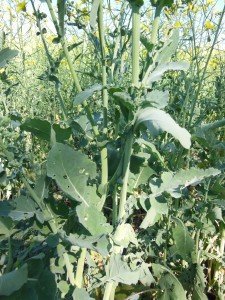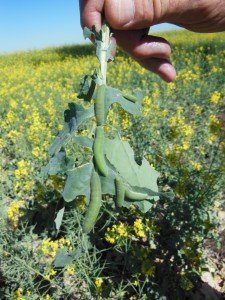As canola sets and matures pods, and spring temperatures rise, there are a number of caterpillar pests that are active in this crop. Along with helicoverpa there are diamondback moth larvae (Plutella xylostella) and cabbage white butterfly larvae (Pieris rapae) in crops. It is critical that you can distinguish the species, and be familiar with their respective thresholds, in order to make sound decisions about whether control is warranted.
Diamondback moth (DBM), also commonly called cabbage moth, is a sporadic pest in the northern region, and is probably the species with which we are least familiar. This year, DBM numbers are higher than have been seen for some years. DBM caterpillars are typically light green and grow up to 12mm in length. They are tapered at each end and wriggle violently when poked. The uniform colour, tapering and violent wriggling are key distinguishing characteristics that you can use to separate DBM from Helicoverpa larvae. DBM moths are often visible in a flowering crop, particularly in the evening.
Cabbage white butterfly larvae are easily identified. They are round bodied, uniformly green, and characteristically look soft and downy. The adult butterflies are pale yellow-white with a black spot on the forewing.
Watch a short video that shows how to distinguish DBM and helicoverpa larvae.
Thresholds
DBM thresholds vary depending on the stage of crop development and the risk to crop growth and yield, and are presented in table 1 below. DBM larvae will feed on foliage, and on flowers and developing pods. Once pods are mature, larvae will graze on the surface of pods causing ‘windowing’, but rarely penetrate pods and affecting yield.
No work has been done to compare the relative efficacy of sweepnet and beatsheet sampling. However, I estimate that beatsheeting 1 m of row (not a square metre), is approximately equivalent to 3 sweeps. Therefore, use the above thresholds for a 3m of row beatsheet sample (or divide by 3 if using a 1m row average). If you want to work on a square metre basis, then there is approximately 3m of crop row (on 30cm row spacing), so use the same threshold value as for the 10 sweeps.
The Helicoverpa threshold has not been validated for the northern region, so we are working with the threshold established some years ago in the south/west of 5-10 larvae per 10 sweeps. Again, converting sweeps to beatsheet estimates described for DBM above.
There is no established threshold for cabbage white butterfly. This species is not known to be economically damaging to canola.
Management
DBM populations can change quickly, and a decision to treat should not be made on a single sampling occasion, unless numbers are well above threshold and signifiant damage to pods is evident. Wind, rain and disease can result in rapid decline in DBM populations, and cool conditions will slow activity. Conversely, warm conditions can accelerate population growth and larval feeding activity. If DBM numbers are approaching threshold, recheck the crop in 3-4 days to determine what the population is doing.
Controlling DBM can be challenging with some populations in the south having resistance to synthetic pyrethroids. We don’t know what the resistance status of DBM is in the northern region canola crops, but it would be prudent to expect there to be some level of resistance. Other registered options are Affirm®, Success Neo® and Bt.
For more information on DBM and management options, read the GRDC factsheet.
Helicoverpa larvae will graze on developing and maturing pods, with medium and large larvae able to penetrate pods and consume grain. In conjunction with estimating larval densities, estimating the proportion of damaged pods will help in determining if the population warrants control. As the crop dries down and pods harden, it is less likely that smaller larvae will be able to penetrate pods. In the northern region, the proportion of H. armigera can be expected to increase from late September through to mid October when emergence from winter diapause typically occurs.
DBM activity is also high in southern Australia this year, as discussed in this GRDC media release.



